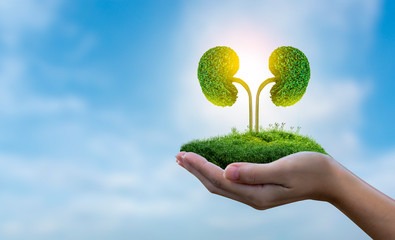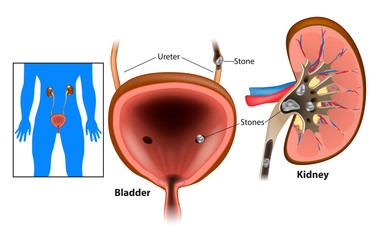8 Ways to Naturally Dissolve Kidney Stones
KIDNEY STONES


If you’ve faced the challenge of a kidney stone, it’s understandable to feel concerned about the possibility of it happening again. It’s true that there’s a chance of recurrence within 5 to 10 years. But there’s good news: by making mindful dietary choices, you can help lower this risk.
Kidney stones are indeed a widespread issue, and the experience can be quite distressing. For those who have gone through this ordeal, the thought of a repeat occurrence can be daunting. Yet, take heart, as there are proactive steps you can take to help prevent this.
In the forthcoming article, we’ll delve into the nature of kidney stones and share eight dietary strategies that can aid in warding them off. These tips are not only practical but can also contribute to your overall well-being.
What are Kidney stones
Also referred to as renal stones or nephrolithiasis, are hard formations made of accumulated waste materials in the kidneys. These formations crystallize and can cause discomfort.
There are several types of kidney stones, with calcium oxalate stones being the most prevalent. Other, rarer types include struvite, uric acid, and cysteine stones.
Small kidney stones often pass through the urinary system without causing much trouble. However, larger stones might obstruct the urinary tract as they exit the body, which can result in intense pain, nausea, and sometimes bleeding.
Kidney stones are a significant health concern in India, with the prevalence estimated at around 10% nationwide, affecting approximately 5 to 7 million patients. In North India, which is part of the “stone belt,” nearly 15% of the population is affected by kidney stones. This region has a higher rate of kidney stone disease compared to other parts of the country, and dietary habits, such as the consumption of oxalate-rich foods and dairy products, have been identified as contributing factors.
And if you’ve had one, the chances of having another within the next 5 to 10 years can be as high as 50%.
In the following section, we’ll explore 8 natural methods to help lower the risk of developing kidney stones again, aiming to provide comfort and prevention.
1. Stay hydrated
Maintaining proper hydration is a gentle yet powerful step in preventing kidney stones. It’s advisable to drink ample fluids, as they help dilute the substances in your urine that could potentially form stones, reducing the likelihood of their crystallization.
It’s important to note that not all beverages are equally beneficial in this regard. Drinking plenty of water is particularly effective and is associated with a reduced risk of developing kidney stones. Similarly, moderate consumption of coffee, tea, beer, wine, and orange juice may also contribute to a lower risk.
Conversely, excessive intake of sodas, whether sugar-sweetened or artificially sweetened, might increase the risk of kidney stone formation. Sugar-sweetened beverages, in particular, contain fructose, which can lead to greater excretion of calcium, oxalate, and uric acid—key contributors to kidney stone risk.
Moreover, some research suggests that the phosphoric acid found in high quantities in colas, regardless of their sugar content, may elevate the risk of kidney stones. Therefore, it’s wise to choose your beverages thoughtfully to support your kidney health.
2. Increase your citric acid intake
Citric acid, a natural compound found in a variety of fruits and vegetables, is particularly abundant in citrus fruits like lemons and limes.
This beneficial acid can aid in the prevention of calcium oxalate kidney stones in two significant ways:
Inhibiting Stone Formation: Citric acid has the ability to combine with calcium in the urine, which can help reduce the chances of new stone formation.
Preventing Stone Growth: By binding to existing calcium oxalate crystals, citric acid can prevent them from increasing in size, aiding in the passage of these crystals before they develop into larger stones.
To increase your intake of citric acid, consider incorporating more citrus fruits into your diet, such as grapefruit, oranges, lemons, or limes. Additionally, adding a splash of lemon or lime juice to your water is a simple yet effective method to boost your citric acid consumption.
3. Limit foods high in oxalates
Oxalate, also known as oxalic acid, is a substance found naturally in a variety of plant-based foods such as leafy greens, fruits, vegetables, and cocoa. Additionally, your body produces a significant amount of oxalate on its own.
An increased intake of oxalate can lead to higher oxalate levels in the urine, which may pose a problem for individuals prone to forming calcium oxalate crystals.
Oxalate has the ability to combine with calcium and other minerals to create crystals that have the potential to develop into kidney stones.
Nonetheless, it’s worth noting that many oxalate-rich foods are also nutrient-dense and beneficial to health, which is why a stringent low-oxalate diet is not universally recommended for everyone with kidney stones.
Typically, a diet low in oxalate is advised only for those with hyperoxaluria, a condition marked by excessive oxalate in the urine.
It’s important to seek advice from a healthcare provider or a dietitian before making any dietary changes, especially to determine if reducing oxalate intake is appropriate for your situation.
4. Don’t take high doses of vitamin C
Research suggests that taking vitamin C supplements might be linked to a greater likelihood of developing kidney stones.
Excessive consumption of vitamin C supplements can lead to a higher output of oxalate in the urine because the body can convert some of the vitamin C into oxalate.
A study conducted in Sweden on men of middle to older age found that those who took vitamin C supplements had a risk of kidney stones that was double the risk of those who did not take these supplements.
It’s important to highlight, however, that vitamin C obtained from dietary sources, like lemons, does not carry the same risk for kidney stones.
5. Get enough calcium
Contrary to popular belief, reducing calcium intake is not necessary to lower the risk of developing calcium-based kidney stones. In reality, a diet with adequate calcium may actually help decrease the chance of kidney stone formation.
A particular study observed men with a history of calcium kidney stones who consumed a diet with 1,200 mg of calcium daily, alongside reduced animal protein and salt. These men experienced a roughly 50% reduction in the risk of forming another kidney stone over five years compared to those on a low-calcium diet of 400 mg per day.
Calcium in the diet has the beneficial effect of binding with dietary oxalate, which inhibits its absorption and spares the kidneys from processing it.
Dairy products such as milk, cheese, and yogurt are excellent sources of dietary calcium.
The general recommended daily allowance for calcium is 1,000 mg for most adults, while it increases to 1,200 mg for women over 50 years old and for all individuals over 70 years old. It’s always best to consult with a healthcare provider to determine the appropriate calcium intake for your specific needs.
6. Cut back on salt
Consuming a diet with excessive salt may elevate the risk of kidney stones for certain individuals.
High sodium consumption, which is found in table salt, can lead to an increase in the urinary excretion of calcium, a key factor in the development of kidney stones.
However, it’s worth noting that not all research, particularly among younger adults, has established a clear link.
Dietary guidelines generally advise limiting sodium intake to 2,300 mg daily, yet many people’s intake surpasses this recommendation.
Reducing sodium consumption can often be effectively achieved by minimizing the intake of processed and packaged foods.
7. Increase your magnesium intake
Magnesium plays a crucial role in numerous bodily functions, including energy generation and muscle contractions, yet it’s often lacking in the average diet.
Some research indicates that magnesium might be beneficial in preventing the formation of calcium oxalate kidney stones. While the exact mechanism is not completely clear, it’s believed that magnesium could potentially decrease the absorption of oxalate in the intestines.
However, the scientific community has not reached a consensus on this effect.
The recommended daily intake for magnesium is 420 mg. Foods like avocados, legumes, and tofu are excellent sources of magnesium.
For optimal results, it’s suggested to pair magnesium intake with oxalate-rich foods or to ensure magnesium consumption within 12 hours of eating foods high in oxalate.
8. Eat less animal protein
Consuming a diet that is rich in animal proteins — including meat, fish, and dairy products — has been linked to an elevated risk of developing kidney stones.
Eating large amounts of animal protein can lead to increased elimination of calcium and a reduction in citrate levels in the body.
Moreover, foods derived from animals tend to have high concentrations of purines, which are metabolized into uric acid and could heighten the likelihood of uric acid stone formation.
While purines are present in all foods to some degree, organ meats such as kidney and liver contain particularly high levels. Conversely, plant-based foods generally have lower purine content
The bottom line
If you’ve previously encountered kidney stones, it’s understandable to be concerned about the possibility of their recurrence. It’s true that there’s a likelihood of experiencing them again within the next 5 to 10 years. However, there’s reassuring news: by embracing certain dietary changes, you can significantly diminish this risk.
Consider enhancing your fluid consumption, opting for nutrient-dense foods, moderating your intake of animal proteins, and reducing sodium in your diet.
These straightforward yet impactful steps can contribute greatly to safeguarding yourself against the discomfort of kidney stones. Your proactive measures can make a substantial difference in your health and well-being.


